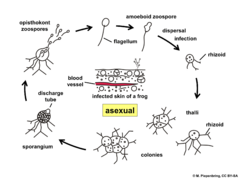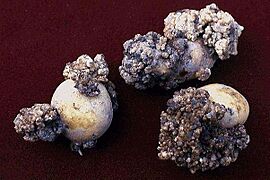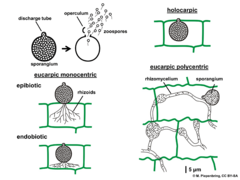Chytridiomycota facts for kids
Quick facts for kids Chytridiomycota |
|
|---|---|
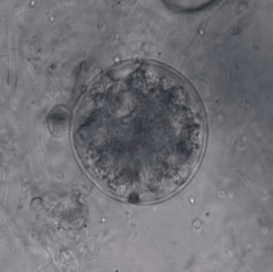 |
|
| Sporangium of a spizellomycete | |
| Scientific classification |
|
| Unrecognized taxon (fix): | Chytridiomycota |
| Classes/orders | |
|
|
Chytridiomycota are a group of tiny living things in the kingdom Fungi. They are often called chytrids for short. The name "chytrid" comes from an old Greek word meaning "little pot." This describes the shape of the part that holds their tiny zoospores.
Chytrids are some of the oldest types of fungi. We know they are fungi because they have chitin in their cell walls, like insects. They also have a special tail called a flagellum that helps them move. Chytrids get their food by absorbing it, and they store energy using glycogen.
Chytrids often act as decomposers, breaking down tough materials like chitin and keratin. Sometimes, they can also be parasites. Scientists have been studying chytrids a lot more since they found out about Batrachochytrium dendrobatidis. This chytrid causes a serious disease called chytridiomycosis in amphibians.
Contents
About Chytrids
How Chytrids Are Grouped
Scientists used to group chytrids based on how they grew and looked. But now, they use more modern methods. They look at their DNA and the tiny details of their zoospores. This helps them classify chytrids more accurately.
Chytrids were once thought to be part of other groups, but now they are firmly placed in the Fungi kingdom. There are over 750 different kinds of chytrids.
How Chytrids Live: Life Cycle and Body Plan
Chytrids are special among fungi because they use tiny, swimming cells called zoospores to reproduce. For many chytrids, we don't know much about their sexual reproduction. They usually reproduce without a partner by releasing zoospores.
When sexual reproduction does happen, the chytrid forms a special "resting spore." This spore helps them survive when conditions are bad. Some chytrids have male and female cells that look the same. Others have a small, moving male cell that joins with a larger, non-moving female cell.
The Monoblepharidomycetes group of chytrids often reproduce sexually. The male cells can move, but the female cells stay still. After the male and female cells join, they form a spore that can grow into new chytrids.
-
Life cycle of Batrachochytrium dendrobatidis
When zoospores are released, they look for a good place to grow. They might use chemicals or light to find a spot. Once they land, they start to break down food from their surroundings. This helps them grow into a new chytrid body, called a thallus.
Chytrids have different ways of growing:
- Some are holocarpic: They only make a zoosporangium (the "pot") and zoospores.
- Others are eucarpic: They make other parts, like root-like structures called rhizoids, along with the zoosporangium.
- Some are monocentric: One zoospore grows into one zoosporangium.
- Others are polycentric: One zoospore can grow into many zoosporangia connected by a network.
-
Sporangium and zoospores of the chytrid fungus B. dendrobatidis, under a scanning electron microscope
When new zoospores are ready, they are released. Chytrids have different ways to do this. Some have a lid-like structure that opens up. Others release their zoospores through small holes or slits.
Where Chytrids Live
Chytrids are often called aquatic fungi because they need water to move their zoospores. Even those found in soil live in the tiny water spaces between soil particles.
You can find chytrids in many watery places, like ponds, rivers, and bogs. They also live in different types of soil, from acidic to alkaline, and even in cold Arctic and Antarctic soils. This makes scientists think that many chytrid species are found almost everywhere.
Scientists used to think that chytrids were mostly active in cooler seasons. But new studies show that they are active and diverse in lakes even during the summer. Chytrids can even live in very cold soils near glaciers, where there isn't much plant life. They survive there because of the water in the soil and pollen that blows in.
What Chytrids Do in Nature
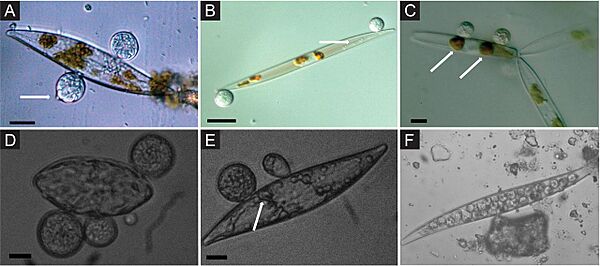
Batrachochytrium dendrobatidis and Amphibians
The chytrid called Batrachochytrium dendrobatidis causes a disease in amphibians called chytridiomycosis. This disease was first found in 1998 in Australia and Panama. It has killed many amphibians around the world. Scientists believe it's a main reason why frog populations are declining.
For example, this fungus caused many Kihansi Spray Toads to die in Tanzania. It also led to the extinction of the golden toad in 1989. The disease makes frogs lose important salts through their skin, which can kill them.
Some research suggests that adding a little salt to water might help cure this disease in certain Australian frogs. More studies are needed to confirm this.
Other Parasites
Chytrids can also infect algae and other tiny living things. Sometimes, their infections are so strong that they can control how much food is produced in a lake. This means they can have a big effect on the food webs in lakes and ponds.
Chytrids can also infect plants. For example, Synchytrium endobioticum is a chytrid that causes a disease in potatoes.
Chytrids as Decomposers
One of the most important jobs chytrids do in nature is decomposition. These fungi are found everywhere and help break down tough materials. They can break down things like pollen, cellulose (found in plants), chitin (found in insect shells), and keratin (found in hair and nails).
Some chytrids even grow on pollen grains. They attach thread-like structures called rhizoids to the pollen. This often happens in spring when pollen falls into water. The chytrids reproduce on the pollen, using it for nutrients.
Chytrids in History
The oldest chytrid fossils were found in Scotland. They are from a time called the Devonian period, which was millions of years ago. These fossils show chytrids living as parasites on ancient plants. They look a lot like a modern chytrid called Allomyces. Other chytrid-like fossils have been found in France, dating back about 300 to 350 million years ago.
Chytrids in Stories
In the novel Tom Clancy's Splinter Cell: Fallout (2007), there's a type of chytrid that eats oil. In the story, this chytrid is changed using radiation to make it eat oil faster. Bad guys then try to use it to destroy the world's oil supplies. This would take away the technological advantage of the United States.
See also
 In Spanish: Quitridios para niños
In Spanish: Quitridios para niños


